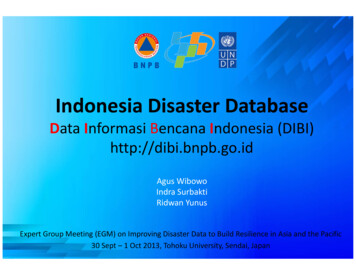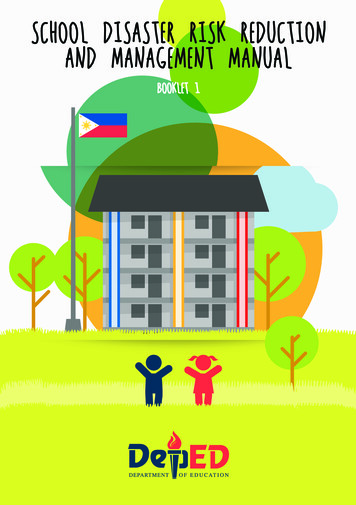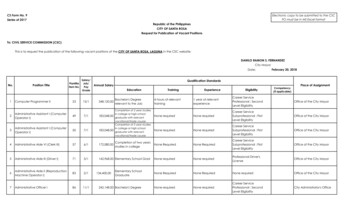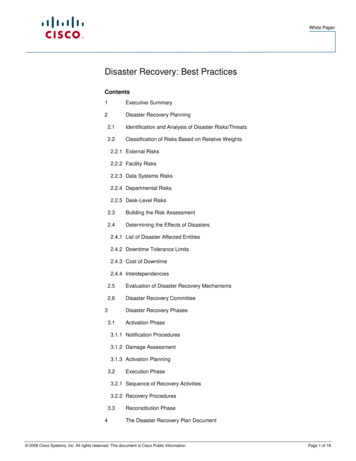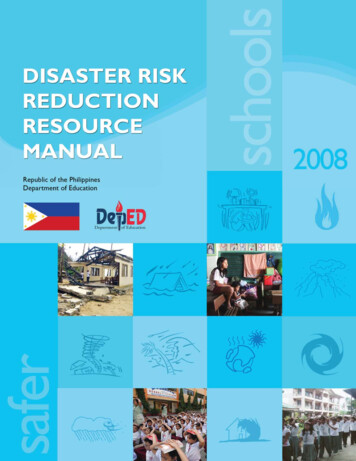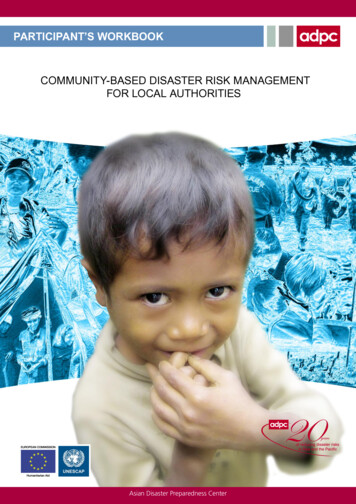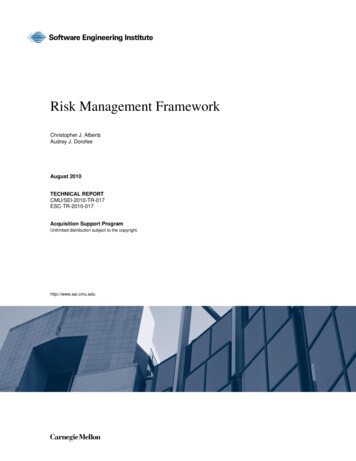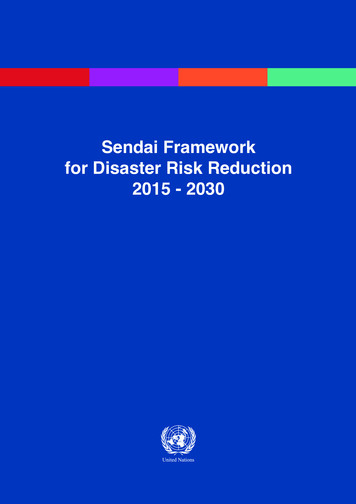
Transcription
Sendai Frameworkfor Disaster Risk Reduction2015 - 20301
Sendai Frameworkfor Disaster Risk Reduction2015-2030
Table of ContentsForeword5Sendai Frameworkfor Disaster Risk Reduction 2015-20307Index28Chart36
ForewordThe Sendai Framework for Disaster Risk Reduction 2015-2030 was adopted at the ThirdUN World Conference in Sendai, Japan, on March 18, 2015. It is the outcome of stakeholderconsultations initiated in March 2012 and inter-governmental negotiations from July 2014to March 2015, supported by the United Nations Office for Disaster Risk Reduction at therequest of the UN General Assembly.The Sendai Framework is the successor instrument to the Hyogo Framework for Action(HFA) 2005-2015: Building the Resilience of Nations and Communities to Disasters. TheHFA was conceived to give further impetus to the global work under the InternationalFramework for Action for the International Decade for Natural Disaster Reduction of 1989,and the Yokohama Strategy for a Safer World : Guidelines for Natural Disaster Prevention,Preparedness and Mitigation and its Plan of Action, adopted in 1994 and the InternationalStrategy for Disaster Reduction of 1999.The Sendai Framework is built on elements which ensure continuity with the work doneby States and other stakeholders under the HFA and introduces a number of innovationsas called for during the consultations and negotiations. Many commentators haveidentified the most significant shifts as a strong emphasis on disaster risk managementas opposed to disaster management, the definition of seven global targets, the reductionof disaster risk as an expected outcome, a goal focused on preventing new risk, reducingexisting risk and strengthening resilience, as well as a set of guiding principles, includingprimary responsibility of states to prevent and reduce disaster risk, all-of-society andall-of-State institutions engagement. In addition, the scope of disaster risk reduction hasbeen broadened significantly to focus on both natural and man-made hazards and relatedenvironmental, technological and biological hazards and risks. Health resilience is stronglypromoted throughout.The Sendai Framework also articulates the following: the need for improved understandingof disaster risk in all its dimensions of exposure, vulnerability and hazard characteristics; thestrengthening of disaster risk governance, including national platforms; accountability fordisaster risk management; preparedness to “Build Back Better”; recognition of stakeholdersand their roles; mobilization of risk-sensitive investment to avoid the creation of new risk;resilience of health infrastructure, cultural heritage and work-places; strengthening ofinternational cooperation and global partnership, and risk-informed donor policies andprograms, including financial support and loans from international financial institutions.There is also clear recognition of the Global Platform for Disaster Risk Reduction and theregional platforms for disaster risk reduction as mechanisms for coherence across agendas,monitoring and periodic reviews in support of UN Governance bodies.UNISDR has been tasked to support the implementation, follow-up and review of theSendai Framework.Margareta Wahlström,United Nations Special Representative ofthe Secretary-General for Disaster Risk Reduction5
Sendai Frameworkfor Disaster Risk Reduction2015-2030ContentsPreamble9Expected outcome and goal12Guiding principles13Priorities for action14Priority 1: Understanding disaster risk14Priority 2: Strengthening disaster risk governanceto manage disaster risk17Priority 3: Investing in disaster risk reduction for resilience18Priority 4: Enhancing disaster preparedness for effectiveresponse and to “Build Back Better” in recovery, rehabilitationand reconstruction21Role of stakeholders23International cooperation and global partnership247
I. Preamble1. The Sendai Framework for Disaster Risk Reduction 2015–2030 was adopted at the ThirdUnited Nations World Conference on Disaster Risk Reduction, held from 14 to 18 March 2015 inSendai, Miyagi, Japan, which represented a unique opportunity for countries:(a) To adopt a concise, focused, forward-looking and action-oriented post 2015 frameworkfor disaster risk reduction;(b) To complete the assessment and review of the implementation of the Hyogo Frameworkfor Action 2005–2015: Building the Resilience of Nations and Communities to Disasters;1(c) To consider the experience gained through the regional and national strategies/institutions and plans for disaster risk reduction and their recommendations, as wellas relevant regional agreements for the implementation of the Hyogo Framework forAction;(d) To identify modalities of cooperation based on commitments to implement a post 2015framework for disaster risk reduction;(e) To determine modalities for the periodic review of the implementation of a post 2015framework for disaster risk reduction.2. During the World Conference, States also reiterated their commitment to address disasterrisk reduction and the building of resilience2 to disasters with a renewed sense of urgency withinthe context of sustainable development and poverty eradication, and to integrate, as appropriate,both disaster risk reduction and the building of resilience into policies, plans, programmes andbudgets at all levels and to consider both within relevant frameworks.Hyogo Framework for Action: lessons learned, gaps identified and future challenges3. Since the adoption of the Hyogo Framework for Action in 2005, as documented in nationaland regional progress reports on its implementation as well as in other global reports, progresshas been achieved in reducing disaster risk at local, national, regional and global levels bycountries and other relevant stakeholders, leading to a decrease in mortality in the case ofsome hazards.3 Reducing disaster risk is a cost-effective investment in preventing future losses.Effective disaster risk management contributes to sustainable development. Countries haveenhanced their capacities in disaster risk management. International mechanisms for strategicadvice, coordination and partnership development for disaster risk reduction, such as the GlobalPlatform for Disaster Risk Reduction and the regional platforms for disaster risk reduction, aswell as other relevant international and regional forums for cooperation, have been instrumentalin the development of policies and strategies and the advancement of knowledge and mutuallearning. Overall, the Hyogo Framework for Action has been an important instrument for raisingpublic and institutional awareness, generating political commitment and focusing and catalysingactions by a wide range of stakeholders at all levels.1. A/CONF.206/6 and Corr.1, chap. I, resolution 2.2. Resilience is defined as: “The ability of a system, community or society exposed to hazards to resist, absorb,accommodate to and recover from the effects of a hazard in a timely and efficient manner, including through thepreservation and restoration of its essential basic structures and functions”, United Nations Office for Disaster RiskReduction (UNISDR), “2009 UNISDR Terminology on Disaster Risk Reduction”, Geneva, May 2009 zard is defined in the Hyogo Framework for Action as: “A potentially damaging physical event, phenomenon or humanactivity that may cause the loss of life or injury, property damage, social and economic disruption or environmentaldegradation. Hazards can include latent conditions that may represent future threats and can have different origins:natural (geological, hydrometeorological and biological) or induced by human processes (environmental degradation andtechnological hazards).9
4. Over the same 10 year time frame, however, disasters have continued to exact a heavy tolland, as a result, the well-being and safety of persons, communities and countries as a whole havebeen affected. Over 700 thousand people have lost their lives, over 1.4 million have been injuredand approximately 23 million have been made homeless as a result of disasters. Overall, morethan 1.5 billion people have been affected by disasters in various ways, with women, childrenand people in vulnerable situations disproportionately affected. The total economic loss wasmore than 1.3 trillion. In addition, between 2008 and 2012, 144 million people were displaced bydisasters. Disasters, many of which are exacerbated by climate change and which are increasingin frequency and intensity, significantly impede progress towards sustainable development.Evidence indicates that exposure of persons and assets in all countries has increased fasterthan vulnerability4 has decreased, thus generating new risks and a steady rise in disasterrelated losses, with a significant economic, social, health, cultural and environmental impactin the short, medium and long term, especially at the local and community levels. Recurringsmall-scale disasters and slow-onset disasters particularly affect communities, households andsmall and medium-sized enterprises, constituting a high percentage of all losses. All countries– especially developing countries, where the mortality and economic losses from disastersare disproportionately higher – are faced with increasing levels of possible hidden costs andchallenges in order to meet financial and other obligations.5. It is urgent and critical to anticipate, plan for and reduce disaster risk in order to moreeffectively protect persons, communities and countries, their livelihoods, health, culturalheritage, socioeconomic assets and ecosystems, and thus strengthen their resilience.6. Enhanced work to reduce exposure and vulnerability, thus preventing the creation ofnew disaster risks, and accountability for disaster risk creation are needed at all levels. Morededicated action needs to be focused on tackling underlying disaster risk drivers, such as theconsequences of poverty and inequality, climate change and variability, unplanned and rapidurbanization, poor land management and compounding factors such as demographic change,weak institutional arrangements, non-risk-informed policies, lack of regulation and incentivesfor private disaster risk reduction investment, complex supply chains, limited availability oftechnology, unsustainable uses of natural resources, declining ecosystems, pandemics andepidemics. Moreover, it is necessary to continue strengthening good governance in disasterrisk reduction strategies at the national, regional and global levels and improving preparednessand national coordination for disaster response, rehabilitation and reconstruction, and to usepost-disaster recovery and reconstruction to “Build Back Better”, supported by strengthenedmodalities of international cooperation.7. There has to be a broader and a more people-centred preventive approach to disasterrisk. Disaster risk reduction practices need to be multi-hazard and multisectoral, inclusive andaccessible in order to be efficient and effective. While recognizing their leading, regulatory andcoordination role, Governments should engage with relevant stakeholders, including women,children and youth, persons with disabilities, poor people, migrants, indigenous peoples,volunteers, the community of practitioners and older persons in the design and implementationof policies, plans and standards. There is a need for the public and private sectors and civilsociety organizations, as well as academia and scientific and research institutions, to work moreclosely together and to create opportunities for collaboration, and for businesses to integratedisaster risk into their management practices.8. International, regional, subregional and transboundary cooperation remains pivotal insupporting the efforts of States, their national and local authorities, as well as communitiesand businesses, to reduce disaster risk. Existing mechanisms may require strengthening inorder to provide effective support and achieve better implementation. Developing countries, inparticular the least developed countries, small island developing States, landlocked developingcountries and African countries, as well as middle-income countries facing specific challenges,need special attention and support to augment domestic resources and capabilities throughbilateral and multilateral channels in order to ensure adequate, sustainable, and timely means ofimplementation in capacity-building, financial and technical assistance and technology transfer,in accordance with international commitments.4. Vulnerability is defined in the Hyogo Framework for Action as: “The conditions determined by physical, social, economicand environmental factors or processes, which increase the susceptibility of a community to the impact of hazards”.10
9. Overall, the Hyogo Framework for Action has provided critical guidance in efforts to reducedisaster risk and has contributed to the progress towards the achievement of the MillenniumDevelopment Goals. Its implementation has, however, highlighted a number of gaps in addressingthe underlying disaster risk factors, in the formulation of goals and priorities for action,5 in theneed to foster disaster resilience at all levels and in ensuring adequate means of implementation.The gaps indicate a need to develop an action-oriented framework that Governments andrelevant stakeholders can implement in a supportive and complementary manner, and whichhelps to identify disaster risks to be managed and guides investment to improve resilience.10. Ten years after the adoption of the Hyogo Framework for Action, disasters continue toundermine efforts to achieve sustainable development.11. The intergovernmental negotiations on the post 2015 development agenda, financing fordevelopment, climate change and disaster risk reduction provide the international communitywith a unique opportunity to enhance coherence across policies, institutions, goals, indicatorsand measurement systems for implementation, while respecting the respective mandates.Ensuring credible links, as appropriate, between these processes will contribute to buildingresilience and achieving the global goal of eradicating poverty.12. It is recalled that the outcome document of the United Nations Conference on SustainableDevelopment, held in 2012, entitled “The future we want”,6 called for disaster risk reductionand the building of resilience to disasters to be addressed with a renewed sense of urgencyin the context of sustainable development and poverty eradication and, as appropriate, to beintegrated at all levels. The Conference also reaffirmed all the principles of the Rio Declarationon Environment and Development.713. Addressing climate change as one of the drivers of disaster risk, while respecting themandate of the United Nations Framework Convention on Climate Change,8 represents anopportunity to reduce disaster risk in a meaningful and coherent manner throughout theinterrelated intergovernmental processes.14. Against this background, and in order to reduce disaster risk, there is a need to addressexisting challenges and prepare for future ones by focusing on monitoring, assessing andunderstanding disaster risk and sharing such information and on how it is created; strengtheningdisaster risk governance and coordination across relevant institutions and sectors and thefull and meaningful participation of relevant stakeholders at appropriate levels; investing inthe economic, social, health, cultural and educational resilience of persons, communities andcountries and the environment, as well as through technology and research; and enhancingmulti-hazard early warning systems, preparedness, response, recovery, rehabilitation andreconstruction. To complement national action and capacity, there is a need to enhanceinternational cooperation between developed and developing countries and between States andinternational organizations.15. The present Framework will apply to the risk of small-scale and large-scale, frequent andinfrequent, sudden and slow-onset disasters caused by natural or man-made hazards, as well asrelated environmental, technological and biological hazards and risks. It aims to guide the multihazard management of disaster risk in development at all levels as well as within and across allsectors.5. The Hyogo Framework priorities for action 2005-2015 are: (1) ensure that disaster risk reduction is a national anda local priority with a strong institutional basis for implementation; (2) identify, assess and monitor disaster risks andenhance early warning; (3) use knowledge, innovation and education to build a culture of safety and resilience at alllevels; (4) reduce the underlying risk factors; and (5) strengthen disaster preparedness for effective response at all levels6. A/RES/66/288, annex.7. Report of the United Nations Conference on Environment and Development, Rio de Janeiro, 3-14 June 1992, vol. I,Resolutions Adopted by the Conference (United Nations publication, Sales No. E.93.I.8 and corrigendum), resolution 1,annex I.8. The climate change issues mentioned in this Framework remain within the mandate of the United Nations FrameworkConvention on Climate Change under the competences of the Parties to the Convention.11
II. Expected outcome and goal16. While some progress in building resilience and reducing losses and damages has beenachieved, a substantial reduction of disaster risk requires perseverance and persistence, with amore explicit focus on people and their health and livelihoods, and regular follow-up. Building onthe Hyogo Framework for Action, the present Framework aims to achieve the following outcomeover the next 15 years:The substantial reduction of disaster risk and losses in lives, livelihoods and health and inthe economic, physical, social, cultural and environmental assets of persons, businesses,communities and countries.The realization of this outcome requires the strong commitment and involvement of politicalleadership in every country at all levels in the implementation and follow-up of the presentFramework and in the creation of the necessary conducive and enabling environment.17. To attain the expected outcome, the following goal must be pursued:Prevent new and reduce existing disaster risk through the implementation ofintegrated and inclusive economic, structural, legal, social, health, cultural, educational,environmental, technological, political and institutional measures that prevent and reducehazard exposure and vulnerability to disaster, increase preparedness for response andrecovery, and thus strengthen resilience.The pursuance of this goal requires the enhancement of the implementation capacity andcapability of developing countries, in particular the least developed countries, small islanddeveloping States, landlocked developing countries and African countries, as well as middleincome countries facing specific challenges, including the mobilization of support throughinternational cooperation for the provision of means of implementation in accordance with theirnational priorities.18. To support the assessment of global progress in achieving the outcome and goal of thepresent Framework, seven global targets have been agreed. These targets will be measured atthe global level and will be complemented by work to develop appropriate indicators. Nationaltargets and indicators will contribute to the achievement of the outcome and goal of the presentFramework. The seven global targets are:(a) Substantially reduce global disaster mortality by 2030, aiming to lower the average per100,000 global mortality rate in the decade 2020–2030 compared to the period 2005–2015;(b) Substantially reduce the number of affected people globally by 2030, aiming to lowerthe average global figure per 100,000 in the decade 2020–2030 compared to the period2005–2015;9(c) Reduce direct disaster economic loss in relation to global gross domestic product (GDP) by2030;(d) Substantially reduce disaster damage to critical infrastructure and disruption of basicservices, among them health and educational facilities, including through developing theirresilience by 2030;(e) Substantially increase the number of countries with national and local disaster riskreduction strategies by 2020;(f) Substantially enhance international cooperation to developing countries through adequateand sustainable support to complement their national actions for implementation of thepresent Framework by 2030;(g) Substantially increase the availability of and access to multi-hazard early warning systemsand disaster risk information and assessments to people by 2030.9. Categories of affected people will be elaborated in the process for post-Sendai work decided by the Conference.12
III. Guiding principles19. Drawing from the principles contained in the Yokohama Strategy for a Safer World: Guidelinesfor Natural Disaster Prevention, Preparedness and Mitigation and its Plan of Action10 and theHyogo Framework for Action, the implementation of the present Framework will be guided bythe following principles, while taking into account national circumstances, and consistent withdomestic laws as well as international obligations and commitments:(a) Each State has the primary responsibility to prevent and reduce disaster risk, includingthrough international, regional, subregional, transboundary and bilateral cooperation.The reduction of disaster risk is a common concern for all States and the extent to whichdeveloping countries are able to effectively enhance and implement national disasterrisk reduction policies and measures in the context of their respective circumstances andcapabilities can be further enhanced through the provision of sustainable internationalcooperation;(b) Disaster risk reduction requires that responsibilities be shared by central Governments andrelevant national authorities, sectors and stakeholders, as appropriate to their nationalcircumstances and systems of governance;(c) Managing the risk of disasters is aimed at protecting persons and their property, health,livelihoods and productive assets, as well as cultural and environmental assets, whilepromoting and protecting all human rights, including the right to development;(d) Disaster risk reduction requires an all-of-society engagement and partnership. It alsorequires empowerment and inclusive, accessible and non discriminatory participation,paying special attention to people disproportionately affected by disasters, especially thepoorest. A gender, age, disability and cultural perspective should be integrated in all policiesand practices, and women and youth leadership should be promoted. In this context, specialattention should be paid to the improvement of organized voluntary work of citizens;(e) Disaster risk reduction and management depends on coordination mechanisms withinand across sectors and with relevant stakeholders at all levels, and it requires the fullengagement of all State institutions of an executive and legislative nature at national andlocal levels and a clear articulation of responsibilities across public and private stakeholders,including business and academia, to ensure mutual outreach, partnership, complementarityin roles and accountability and follow-up;(f) While the enabling, guiding and coordinating role of national and federal State Governmentsremain essential, it is necessary to empower local authorities and local communitiesto reduce disaster risk, including through resources, incentives and decision-makingresponsibilities, as appropriate;(g) Disaster risk reduction requires a multi-hazard approach and inclusive risk-informeddecision-making based on the open exchange and dissemination of disaggregated data,including by sex, age and disability, as well as on easily accessible, up-to-date, comprehensible,science-based, non-sensitive risk information, complemented by traditional knowledge;(h) The development, strengthening and implementation of relevant policies, plans, practicesand mechanisms need to aim at coherence, as appropriate, across sustainable developmentand growth, food security, health and safety, climate change and variability, environmentalmanagement and disaster risk reduction agendas. Disaster risk reduction is essential toachieve sustainable development;(i)While the drivers of disaster risk may be local, national, regional or global in scope, disasterrisks have local and specific characteristics that must be understood for the determinationof measures to reduce disaster risk;(j)Addressing underlying disaster risk factors through disaster risk-informed public andprivate investments is more cost-effective than primary reliance on post-disaster responseand recovery, and contributes to sustainable development;10. A/CONF.172/9, chap. I, resolution 1, annex I.13
(k) In the post-disaster recovery, rehabilitation and reconstruction phase, it is critical to preventthe creation of and to reduce disaster risk by “Building Back Better” and increasing publiceducation and awareness of disaster risk;(l)An effective and meaningful global partnership and the further strengthening ofinternational cooperation, including the fulfilment of respective commitments of officialdevelopment assistance by developed countries, are essential for effective disaster riskmanagement;(m) Developing countries, in particular the least developed countries, small island developingStates, landlocked developing countries and African countries, as well as middle-incomeand other countries facing specific disaster risk challenges, need adequate, sustainable andtimely provision of support, including through finance, technology transfer and capacitybuilding from developed countries and partners tailored to their needs and priorities, asidentified by them.IV. Priorities for action20. Taking into account the experience gained through the implementation of the HyogoFramework for Action, and in pursuance of the expected outcome and goal, there is a need forfocused action within and across sectors by States at local, national, regional and global levels inthe following four priority areas:Priority 1: Understanding disaster risk.Priority 2: Strengthening disaster risk governance to manage disaster risk.Priority 3: Investing in disaster risk reduction for resilience.Priority 4: Enhancing disaster preparedness for effective response and to “Build Back Better”in recovery, rehabilitation and reconstruction.21. In their approach to disaster risk reduction, States, regional and international organizationsand other relevant stakeholders should take into consideration the key activities listed undereach of these four priorities and should implement them, as appropriate, taking into considerationrespective capacities and capabilities, in line with national laws and regulations.22. In the context of increasing global interdependence, concerted international cooperation, anenabling international environment and means of implementation are needed to stimulate andcontribute to developing the knowledge, capacities and motivation for disaster risk reduction atall levels, in particular for developing countries.Priority 1: Understanding disaster risk23. Policies and practices for disaster risk management should be based on an understandingof disaster risk in all its dimensions of vulnerability, capacity, exposure of persons and assets,hazard characteristics and the environment. Such knowledge can be leveraged for the purposeof pre-disaster risk assessment, for prevention and mitigation and for the development andimplementation of appropriate preparedness and effective response to disasters.National and local levels24. To achieve this, it is important:(a) To promote the collection, analysis, management and use of relevant data and practicalinformation and ensure its dissemination, taking into account the needs of different categoriesof users, as appropriate;(b) To encourage the use of and strengthening of baselines and periodically assess disaster risks,vulnerability, capacity, exposure, hazard characteristics and their possible sequential effectsat the relevant social and spatial scale on ecosystems, in line with national circumstances;14
(c) To develop, periodically update and disseminate, as appropriate, location-based disaster riskinformation, including risk maps, to decision makers, the general public and communitiesat risk of exposure to disaster in an appropriate format by using, as applicable, geospatialinformation technology;(d) To systematically evaluate, record, share and publicly account for disaster losses andunderstand the economic, social, health, education, environmental and cultural heritageimpacts, as appropriate, in the context of event-specific hazard-exposure and vulnerabilityinformation;(e) To make non-sensitive hazard-exposure, vulnerability, risk, disaster and loss-disaggregatedinformation freely available and accessible, as appropriate;(f) To promote real time access to reliable data, make use of space and in situ information,including geographic information systems (GIS), and use information and communicationstechnology innovations to enhance measurement tools and the collection, analysis anddissemination of data;(g) To build the knowledge of government officials at all levels, civil society, communities andvolunteers, as well as the private sector, through sharing experiences, lessons learned,good practices and training and education on disaster risk reduction, including the use ofexisting training and education mechanisms and peer learning;(h) To promote and improve dialogue and cooperation among scientific and technologicalcommunities, other relevant stakeholders and policymakers in order to facilitate a sciencepolicy interface for effective decision-making in disaster risk management;(i)To ensure the use of traditional, indigenous and local knowledge and practices, asappropriate, to complement scientific knowledge in disaster risk asse
as relevant regional agreements for the implementation of the Hyogo Framework for Action; (d) To identify modalities of cooperation based on commitments to implement a post 2015 framework for disaster risk reduction; (e) To determine modalities for the periodic review of the implementation of a post 2015 framework for disaster risk reduction. 2.
